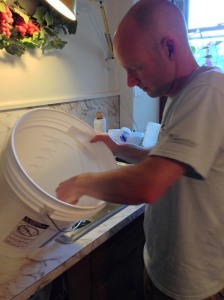We started the California Chardonnay this weekend! While Chardonnay wines are being increasingly sought after as “naked” or fermented and/or aged in stainless steel rather than oak barrels, we decided this kit will be fermentation oaked with the included heavy French Oak shavings. On a process note, one of the things that George at the Winemaker’s Toy Store highly recommends is to fill your primary fermenter with water to the 23L mark after installing the spigot with its gaskets. We have made it a practice to do so and it paid off this time around. Within an inch of the 23L mark, the spigot started dripping from the outer gasket…..so we emptied the water into another bucket, fixed the spigot and checked again.

After finding a leak at the spigot, we transferred the “test” water to another bucket to re-install the spigot and test again.
Had we gotten the fermenter filled with our must or this problem occurred after fermentation began it would’ve been far more of a problem. Worried about wasting 23L of water?….we just fill our watering cans for our garden when done testing the fermenter for leaks. This also drills home another point that having too many buckets in your winery is not possible!











